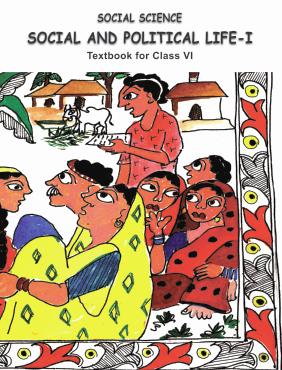NCERT solutions for Class 6 Social Science Civics understanding diversity book solutions are available in PDF format for free download. These ncert book chapter wise questions and answers are very helpful for CBSE exam. CBSE recommends NCERT books and most of the questions in CBSE exam are asked from NCERT text books. Class 6 Social Science chapter wise NCERT solution for Social Science part 1 part 2 and Part 3 for all the chapters can be downloaded from our website and myCBSEguide mobile app for free.
NCERT solutions for Civics Download as PDF

NCERT Class 6 Social Science Chapter Wise Solutions
History – Our Pasts Part I
- Chapter 1 – What, Where, How and when?
- Chapter 2 – On The Trial of the Earliest People
- Chapter 3 – From Gathering to Growing Food
- Chapter 4 – In the Earliest Cities
- Chapter 5 – What Books and Burials Tell Us
- Chapter 6 – Kingdoms, Kings and an Early Republic
- Chapter 7 – New Questions and Ideas
- Chapter 8 – Ashoka, The Emperor Who gave Up War
- Chapter 9 – Vital, Villages and Pilgrims
- Chapter 10 – Traders, Kings and Pilgrims
- Chapter 11 – New Empires and Kingdoms
- Chapter 12 – Bulidings, Paintings and Books
Geography – The Earth Our Habitat Part I
- Chapter 1 – The Earth in the Solar System
- Chapter 2 – Globe: Latitudes and Longitudes
- Chapter 3 – Motions of the Earth
- Chapter 4 – Maps
- Chapter 5 – Major Landforms of the Earth
- Chapter 6 – Major Domains of the Earth
- Chapter 7 – Our Country – India
- Chapter 8 – India: Climate, Vegetation and Wildlife
Civics
- Chapter 1 – Understanding Diversity
- Chapter 2 – Diversity and Discrimination
- Chapter 3 – What is Government
- Chapter 4 – Key Elements of a Democratic Government
- Chapter 5 – Panchayati Raj
- Chapter 6 – Rural Administration
NCERT solutions for Class 6 Social Science Civics understanding diversity
Question 1: Draw up a list of the different festivals celebrated in your locality. Which of these celebrations are shared by members of different regional and religious communities?
Answer: Different festivals celebrated in our locality are:
Holi – Hindus, Sikhs, Jain

Diwali – Hindus, Sikhs, Jain
Id-ul-Fitr – Muslims
Christmas – Christians
Lohri – Hindus, Sikhs
Raksha Bandhan – Hindus, Sikhs, Jain
Good Friday – Christians
But some festivals are celebrated by all the members of different regional and religious communities. These festivals are national festivals- e.g. Independence Day, Republic Day, Gandhi Jayanti, etc. These national festivals are celebrated by every Indian irrespective of region and religion.
Question 2: What do you think living in India with its rich heritage of diversity adds to your life?
Answer: The rich heritage of diversity in India adds variety to our life and enriches our lives in many ways:
- Diversity teaches us to be open-minded and tolerant as we learn many things from each other and share our experiences.
- We celebrate different festivals together and learn different languages, cultures etc. This kind of diversity helps us evolve as better human beings because we respect people with different religious beliefs, viewpoints, tastes, customs, and cultures.
- However, we stand together as Indians despite all these cultural differences. We share the same national symbols, virtues and feelings. A sense of friendship and unity develops and it brings harmony and prosperity.
Question 3: Do you think the term “unity in diversity” is an appropriate term to describe India? What do you think Nehru is trying to say about Indian unity in the sentence quoted above from his book The Discovery of India?
Answer: The phrase “Unity in Diversity” very well describes India. India is a land of various cultures, castes, customs, creed and religions. Still people live in harmony and brotherhood. They celebrate festivals and share their joys and sorrows together. Differences in terms of cultures, religions and languages add enchantment and spice to our lives. This diversity helps us live a harmonious life. In fact, unity in diversity is a base for Indian cultural nationalism.
For example, people from different parts of India rose up and protested against the British rule. Both Hindus and Muslims sacrificed their lives in Jallianwalah Bagh in Amritsar. Nehru ji in his book, “The Discovery of India”, wrote that India was always united in spite of several religious and cultural differences. The people of India were living with peace, with respect for each other’s traditions and with unity.

Question 4: Underline the line in the poem sung after the Jallianwalah Bagh massacre, which according to you, reflects India’s essential unity.
Answer: The line, ‘the blood of Hindus and Muslim flow together today’, reflects India’s essential unity. It means that the Hindus and Muslims struggled and fought together for freedom of the country. Both sacrificed their lives in Jallianwalah Bagh in Amritsar.
Question 5: Choose another region in India and do a similar study of the historical and geographical factors that influence the diversity found there. Are these historical and geographical factors connected to each other? How?
Answer: Ladakh is a desert in the mountains in the eastern part of Jammu and Kashmir. This region does not receive any rain and is covered in snow for a large part of the year, so very little agriculture is possible here. It was considered a good trade route as it had many passes through which caravans travelled to what is today called Tibet. These caravans carried textiles and spices, raw silk and carpets. Buddhism reached Tibet through Ladakh. Ladakh is also called Little Tibet. Islam was introduced in this region more than four hundred years ago and there is a significant Muslim population here.
Kerala is a state in the southwest corner of India. It is surrounded by the sea on one side and hills on the other. A number of spices like pepper, cloves and cardamoms are grown on the hills. It is spices that made this region an attractive place for traders. Christian, Jewish and Arab traders were the first to come here. People in Kerala practise different religions such as Judaism, Islam, Christianity, Hinduism and Buddhism because of all these various historical influences.
Both regions were influenced by Chinese and Arab traders. It was the geography of Kerala which allowed for the cultivation of spices and the special geographical location of Ladakh and its wool that drew traders to these regions. Thus history and geography are often tied in the cultural life of a region.
NCERT Solutions for Class 6 Social Science
NCERT Solutions Class 6 Social Science PDF (Download) Free from myCBSEguide app and myCBSEguide website. Ncert solution class 6 Social Science includes textbook solutions from part 1 and part 2 and part 3 NCERT Solutions for CBSE Class 6 Social Science have total 29 chapters. 6 Social Science NCERT Solutions in PDF for free Download on our website. Ncert Social Science class 6 solutions PDF and Social Science ncert class 6 PDF solutions with latest modifications and as per the latest CBSE syllabus are only available in myCBSEguide.
CBSE app for Class 6
To download NCERT Solutions for class 6 Social Science, Computer Science, Hindi ,English, Maths Science do check myCBSEguide app or website. myCBSEguide provides sample papers with solution, test papers for chapter-wise practice, NCERT solutions, NCERT Exemplar solutions, quick revision notes for ready reference, CBSE guess papers and CBSE important question papers. Sample Paper all are made available through the best app for CBSE students and myCBSEguide website.

Test Generator
Create question paper PDF and online tests with your own name & logo in minutes.
Create Now
Learn8 App
Practice unlimited questions for Entrance tests & government job exams at ₹99 only
Install Now